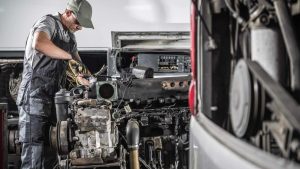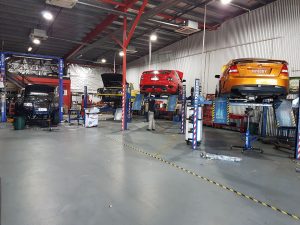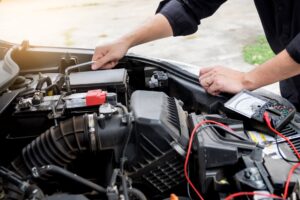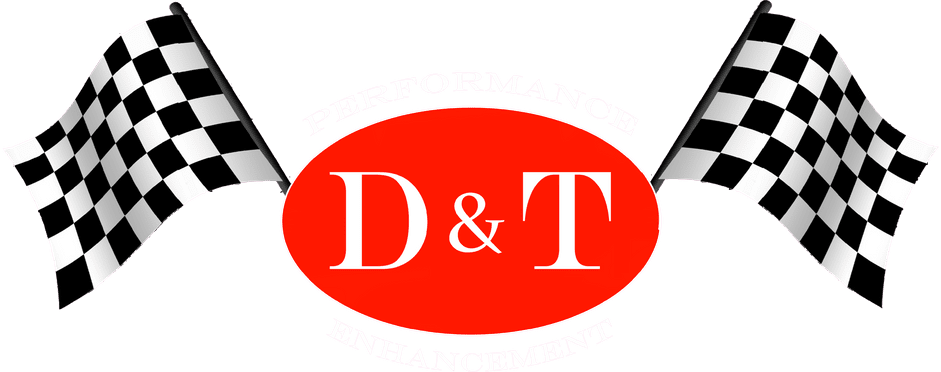
Maintaining our vehicles is essential for their optimal performance, safety, and longevity. One crucial aspect of vehicle maintenance that often goes overlooked is wheel alignment. While it may seem like a minor detail, proper wheel alignment plays a significant role in tire wear and fuel efficiency. In this blog post, we will explore why wheel alignment matters and how it affects these crucial aspects of vehicle performance.
Understanding Wheel Alignment
Wheel alignment refers to the adjustment of the angles at which the wheels make contact with the road surface. It involves three key components: camber, caster, and toe. Camber refers to the tilt of the wheels inward or outward, caster measures the angle of the steering axis, and toe determines whether the wheels point inward or outward. When these angles are misaligned, it can have a negative impact on tire wear and fuel efficiency.
An alignment that is off can cause uneven tire wear, which means your tires may wear out faster than they should. Additionally, misaligned wheels can cause the vehicle to pull to one side, making it harder to keep it in a straight line while driving. This can also lead to reduced fuel efficiency as the resistance from the tires working against each other increases.
How misalignment affects tire wear and fuel efficiency?
Misalignment can cause uneven tire wear, which can lead to the need for premature tire replacement. When the wheels are not properly aligned, certain parts of the tire will experience more friction than others, causing them to wear out faster. This can also compromise the handling of your vehicle, making it less safe to drive.
In addition to tire wear, misalignment can also reduce fuel efficiency. When the wheels are not aligned correctly, it creates additional resistance and drags on the tires, making your engine work harder and burn more fuel. This can result in decreased gas mileage and increased costs at the pump.
Impact of Wheel Alignment on Tire Wear
Misalignment can cause uneven tire wear patterns, leading to premature tire deterioration. For example, excessive negative camber can cause the inner edges of the tires to wear faster, while positive camber can result in the outer edges wearing down quickly. Such irregular wear not only compromises the lifespan of your tires but also affects traction, compromising safety on the road.
The impact of wheel alignment on tire wear cannot be overstated when it comes to maintaining your vehicle’s performance and safety. Properly aligned wheels ensure that the tires make even contact with the road, reducing stress on the tires and preventing premature wear. Neglecting wheel alignment can lead to costly tire replacements and compromise the handling of your vehicle. Therefore, it is important to have your wheels regularly checked by a professional mechanic to ensure they are properly aligned, especially if you notice any irregular wear patterns on your tires.
Impact of Wheel Alignment on Fuel Efficiency
Proper wheel alignment plays a crucial role in reducing rolling resistance, which is the force needed to move the tires along the road. Misalignment increases rolling resistance, causing the engine to work harder and consume more fuel. Studies have shown that vehicles with misaligned wheels can experience a noticeable decrease in fuel efficiency. By maintaining proper wheel alignment, you can maximize your vehicle’s fuel economy and save money at the pump.
These are important considerations for vehicle owners to keep in mind. While it may seem like a small detail, wheel alignment can have a significant impact on fuel efficiency and overall driving performance. It’s recommended to have your alignment checked regularly and corrected as needed to ensure that your vehicle is operating at its most efficient level. By doing so, you’ll not only save money on gas, but also potentially extend the life of your tires and reduce wear and tear on other parts of your vehicle. In short, proper wheel alignment is a smart investment for any responsible car owner.
Signs of Misalignment
Detecting misalignment early is essential to mitigate potential damage. Common signs include your vehicle pulling to one side while driving, a vibrating steering wheel, or uneven tire wear patterns. If you notice any of these symptoms, it’s crucial to have your alignment checked promptly to prevent further issues and expenses.
These signs should not be ignored as continuing to drive with misaligned wheels can cause stress on your vehicle’s suspension system and lead to premature wear and tear on your tires. Additionally, it can negatively impact your vehicle’s fuel efficiency, making it less efficient and more expensive to operate.
If you’re experiencing any of these symptoms, don’t hesitate to take your vehicle to a trusted mechanic for evaluation. They will be able to diagnose the problem accurately and make the necessary adjustments or repairs quickly. By addressing misalignment early on, you can help prolong the life of your vehicle and ensure that it continues to run smoothly for years to come.
Benefits of Proper Wheel Alignment
Ensuring proper wheel alignment offers numerous benefits. First and foremost, it extends the lifespan of your tires, saving you money on premature replacements. Additionally, aligned wheels provide improved traction, enhancing your vehicle’s overall performance and handling. Furthermore, by reducing rolling resistance and optimizing fuel efficiency, proper alignment can lead to long-term savings at the fuel pump.
The benefits of proper wheel alignment also extend to the safety of you and your passengers. Misaligned wheels can cause your vehicle to pull to one side, making it difficult to control, especially in emergency situations. With properly aligned wheels, you’ll have better control over your vehicle, reducing the risk of accidents or collisions.
Moreover, improper alignment can cause wear and tear on other components of your vehicle, such as steering and suspension systems. This can lead to costly repairs and even compromise the overall stability of your vehicle.
Wheel Alignment Procedures and Technologies
Traditionally, wheel alignment involved adjusting the toe and camber angles manually. However, with advancements in technology, modern vehicles often require computerized systems and laser technology for precise alignment measurements and adjustments. It is advisable to seek professional alignment services to ensure accurate results and optimal performance.
The procedure begins by placing the vehicle on a level surface and attaching sensors to each wheel. These sensors measure the current alignment angles and send the data to a computer, which analyzes and compares the readings to factory specifications.
Based on the findings, adjustments are made to bring the wheels into proper alignment. This can include adjusting the camber, toe, and caster angles or making other necessary repairs. Laser technology is often used to assist in these adjustments, providing high-precision results.
Proper wheel alignment is crucial for vehicle safety and performance. Misaligned wheels can cause uneven tire wear, poor handling, and reduced fuel efficiency. In addition, it can also put unnecessary stress on the suspension and steering components, leading to costly repairs down the line. Regular wheel alignments can help prolong the life of your tires and other vehicle parts, while also ensuring a smoother ride and better handling.
Wheel Alignment Maintenance Tips
To maintain proper wheel alignment, it’s important to schedule regular alignment checks and adjustments. Additionally, whenever you replace your tires, it’s crucial to have your alignment checked to ensure the new tires wear evenly. Lastly, adopting good driving habits, such as avoiding potholes and rough roads, can help preserve alignment and prolong tire life.
When it comes to maintaining your vehicle’s performance, wheel alignment is often overlooked but is a crucial component that should not be ignored. Regular alignment checks can help identify and prevent common problems such as uneven tire wear, poor handling, and decreased fuel efficiency. It’s important to take care of your tires by having them rotated and balanced regularly, but proper wheel alignment should always be a priority. So next time you take your car in for maintenance, don’t forget to ask about checking the alignment – it could save you money in the long run!
Conclusion
Wheel alignment is a critical aspect of vehicle maintenance that directly impacts tire wear and fuel efficiency. By understanding the importance of proper alignment, you can take proactive steps to ensure optimal performance, safety, and cost savings. Regular alignment checks, professional services, and attentive driving habits will go a long way in extending tire life, improving fuel efficiency, and enhancing your overall driving experience. Prioritize wheel alignment, and your vehicle will thank you with smoother rides, longer-lasting tires, and better fuel economy.
At DT Performance, we understand the significance of wheel alignment in maintaining a vehicle’s peak performance. Our team of experts is equipped with state-of-the-art equipment and years of experience to provide professional alignment services that will keep your car running smoothly. We recommend scheduling regular alignment checks to identify and prevent any issues before they turn into major problems. Contact us today to book an appointment and experience the difference proper wheel alignment can make!
See Other Related Post

DT Performance is Here to Help – Services We Offer
DT Performance is Here to Help – Services We Offer Are you looking for a reliable and affordable data transmission solution? DT Performance has you

What are the advantages of having anything repaired by a mechanic?
What are the advantages of having anything repaired by a mechanic? The advantages of having anything repaired by a mechanic are many. For one thing,

8 Car Maintenance Tips To Keep Your Car Running Like New
8 Car Maintenance Tips To Keep Your Car Running Like New No one wants to deal with car troubles, but they’re a fact of life.

How to keep your car in top condition?
How to keep your car in top condition? Maintaining your car is essential. You want to keep it in top condition to avoid any costly

Find a Mechanic Near Me: 10 Tips to Choosing the Right One
Find a Mechanic Near Me: 10 Tips to Choosing the Right One https://youtu.be/mL7Fvm9_Y2Q We all know how important it is to have a good Mechanic.

Enhance Your Driving Experience: Engine Performance Upgrades in Darwin, NT
Enhance Your Driving Experience: Engine Performance Upgrades in Darwin, NT Are you tired of driving a sluggish car that lacks power and acceleration? Do you

The Benefits of Choosing a Professional Mechanic
The Benefits of Choosing a Professional Mechanic When it comes time to take your car in for a tune-up, service, or repair, who do you



